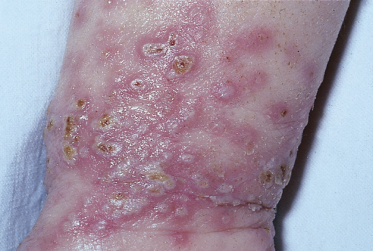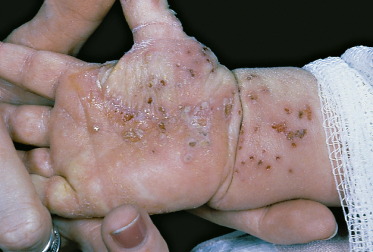Fig. 33.6 Extensive punched-out lesions at 10 days after admission to hospital in a child with a delayed presentation and multisystem involvement.

The signs of eczema herpeticum are sometimes subtle and can be difficult to distinguish from bacterial infection of eczema [28]. Pyrexia is present in 40–75% of cases and is therefore an unreliable sign of eczema herpeticum [28,33,36]. Associated clinical symptoms include intense itching, malaise, vomiting, anorexia, diarrhoea and lymphadenopathy [12]. At the height of the vesicular phase, widespread dissemination of virus may occur and lead to multisystem involvement [40-45]. The eye is rarely infected by HSV in eczema herpeticum, even when there is extensive facial infection [46]. Secondary bacterial infection may be present, usually due to Staphylococcus aureus and group A β-haemolytic streptococcus, although Pseudomonas aeruginosa and Pseudomonas pyocyanosis have been isolated from fatal cases [40,42,47].
Differential Diagnosis.
Difficulty in the clinical diagnosis of eczema herpeticum may arise in the early stages of illness, particularly when vesicles are absent [47]. It may be difficult to distinguish eczema herpeticum from bacterial infection of eczema [28] or severely excoriated eczema. A Tzanck smear, in experienced hands, helps in differentiating viral herpetic infections from bacterial infections [48]. Eczema herpeticum has also been mistakenly diagnosed as chickenpox [12,45].
Treatment and Prevention
Supportive Management
This includes local skin care, antipyretics and analgesics, treatment of secondary bacterial infections with appropriate antibiotics, parenteral fluids to correct dehydration and electrolyte imbalance and blood products as necessary [38]. Topical steroid, tacrolimus or pimecrolimus therapy is often stopped in the acute phase of eczema herpeticum because of concern that these treatments may predispose to cutaneous viral infection and encourage spread of HSV [28,29,43].
Antiviral Therapy
Systemic aciclovir is the treatment of choice for eczema herpeticum. Most children will require intravenous aciclovir, given as an infusion over 1 h, in a dose of 500 mg/m2 three times daily [13,49]. Children who are not systemically unwell and have less extensive lesions respond well to oral aciclovir [50-52]. Some children will have minor localized relapses of HSV infection within 1–2 weeks of eczema herpeticum, and these usually do not require further treatment with aciclovir [49].
General Education
Increased public awareness is needed, particularly for parents, about the risk of contact with ‘cold sores’ for children with atopic dermatitis [40].
Prognosis.
Most children, especially if treated in the first few days of illness, respond quickly to therapy. At the beginning of the 20th century, mortality was high and until 1944, 25% of reported cases had been fatal. Mortality fell significantly in the 1950s as a result of general supportive therapy with parenterally administered fluids, including plasma and blood transfusion [52] and antibiotics for the treatment of secondary bacterial infection [36]. Since the early 1980s, aciclovir has been available for treatment. Fever settles within 2–3 days of commencement of systemic aciclovir, production of vesicles ceases and the skin heals rapidly [12,47].
Eczema herpeticum may, however, present as a fulminating disease with subsequent mortality despite the use of general supportive therapy and intravenous aciclovir [40,53]. Morbidity and mortality are often associated with a delay in presentation [45,47]. The severity of cutaneous HSV infection does not appear to be related to the duration or the extent of eczema [12,35]. Scarring and patchy persistent depigmentation may develop at the sites of infection in severe cases [1,34,39,41].
Stay updated, free articles. Join our Telegram channel

Full access? Get Clinical Tree












